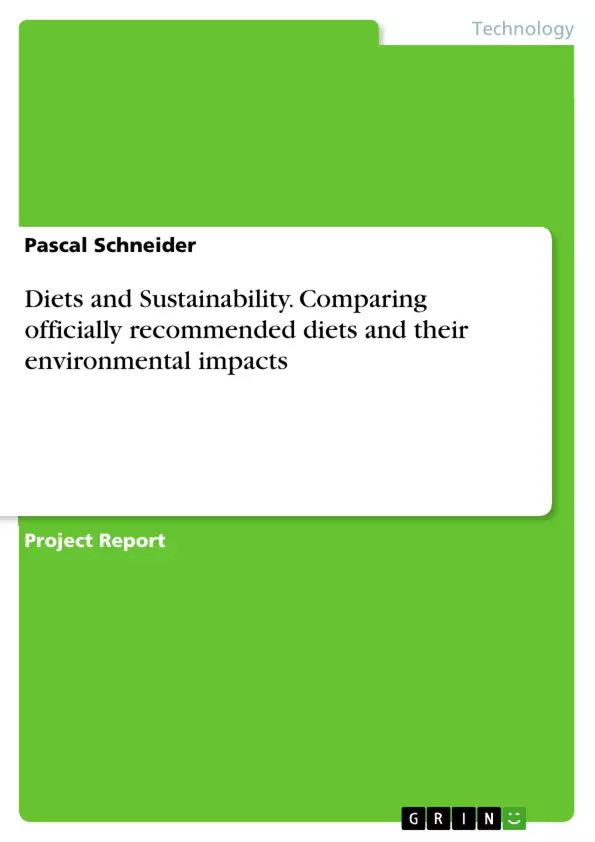It will be a big issue in the future to combine diets with the planetary boundaries. Not only unhealthy eating habits should be reduced through education and transparency of ingredients. Also, the environmental impact will play a role to keep food production possible in the future. The aim of this report is to investigate how the environmental impact of diets over time changed. The focus will be on German food recommendations. Food plates from the German Nutrition Society (DGE) from 1955 until today will be analyzed as possible diets, that are seen as practicable and healthy from the respective time perspective. The environmental impact can be externalities like GHG emissions, biodiversity loss, eutrophication, et cetera. The report stays broader with the externalities and will use a literature analysis to find out how a diet in general can be seen both as healthy and environmentally friendly rather than focusing on one outcome.
Not only is climate change influencing food production. Additionally, the food sector is the main accelerator of climate change, responsible for 10-12 % of total human greenhouse gas (GHG) emissions. Increasing crop production is made possible through a higher yield per hectare, but agriculture today is more and more reliant on fertilizer and pesticide use which is accelerating biodiversity loss: Agriculture influences the phosphorus and nitrogen cycles, leading to water pollution and eutrophication. Pesticide use and monoculture jeopardize pollinators and biodiversity.
Food recommendations by the German Nutrition Society (DGE) have been well developed over time, but give a more superficial impression of a healthy diet. Sustainability aspects are rather randomly implemented what shows that health and sustainability correlate. The diet can still be improved in GHG emissions, for example. However, consumption patterns in today’s societies are still far away from the diet recommendations (too high in animal products, too low in vegetable consumption). This so-called “western diet” is a driver of civilization diseases, biodiversity loss, and GHG emissions.
Inhaltsverzeichnis (Table of Contents)
- Introduction
- Conceptual framework
- Definition of Food Security
- Food Security and malnutrition
- Methodology
- Scoping Review
- Review Protocol
- Analysis & Results
- Data on food consumption
- Tables
- The Energy need for different food groups
- The DGE's Food Plates and their externalities
- Discussion
- Conclusions
- References
Zielsetzung und Themenschwerpunkte (Objectives and Key Themes)
This report aims to investigate the environmental impact of diets over time, focusing on German food recommendations. It analyzes food plates from the German Nutrition Society (DGE) from 1955 until today, evaluating their impact on the environment through externalities such as greenhouse gas emissions, biodiversity loss, and eutrophication.
- Food Security and its connection to Energy Security
- The environmental impact of different diets
- The role of food recommendations in shaping dietary choices
- The interplay between food production and environmental sustainability
- The impact of dietary habits on human health and the environment
Zusammenfassung der Kapitel (Chapter Summaries)
- Introduction: The introduction sets the stage by outlining the challenges of feeding a growing global population and ensuring food security. It highlights the link between food security and energy poverty, the impact of climate change on food production, and the contribution of the food sector to greenhouse gas emissions. The introduction also discusses the ongoing debate about balancing agricultural production with environmental sustainability, highlighting various approaches, including intensification, biodiversity inclusion, and technology-driven solutions.
- Conceptual framework: This chapter defines food security and its relationship to energy security. It explains how food security can be compromised by factors like limited access, affordability, or social pressures. This chapter also discusses the importance of considering health aspects in food choices, highlighting the dangers of diets high in refined sugar, processed food, and unhealthy fats. The chapter concludes by outlining the significance of sustainable food production practices that minimize environmental impact and ensure resilience.
- Methodology: This chapter outlines the research methodology used in the report, including the use of a scoping review and a review protocol. It provides details on how data on food consumption and its related externalities were collected and analyzed.
- Analysis & Results: This section presents the analysis of data on food consumption, focusing on the energy needs of different food groups. It explores the DGE's food plates from various time periods and examines their environmental impacts.
- Discussion: This chapter delves deeper into the findings of the analysis, offering insights into the environmental impacts of different food choices and the influence of food recommendations on dietary habits. It examines the role of sustainability in food production and consumption.
Schlüsselwörter (Keywords)
The main keywords and focus topics of this report include food security, energy security, environmental impact of diets, food recommendations, German Nutrition Society (DGE), food plates, greenhouse gas emissions, biodiversity loss, eutrophication, sustainable food production, and dietary habits.
- Quote paper
- Pascal Schneider (Author), 2020, Diets and Sustainability. Comparing officially recommended diets and their environmental impacts, Munich, GRIN Verlag, https://www.grin.com/document/514854



